Pompeii II.4.7a. Compital Street shrine. Niche compitale. Nicchia compitale.
Excavated 1912, 1933, bombed in 1943, fully excavated 1951-2.

Pompeii II.4.7a. May 2010. Looking east to II.4.7a along the north side of II.4 from II.4.7, showing remains of stucco.
According to Parslow, in the previously unexcavated area between the baths and the compital shrine, Maiuri made a discovery c.1933-34.
Painted on the rough white stucco, beginning 12ft (3.70m) west of the shrine, were electoral recommendations.
These were CIL IV 7575 – 7583 and 7990. They were found in an excellent state but have since faded.
See Rivista di Studi Pompeiani, Vol II, 1988: Parslow, C: Documents illustrating the excavations of the Praedia of Julia Felix (p.45)
According to Epigraphik-Datenbank Clauss/Slaby (See www.manfredclauss.de), these read –
C(aium)
C(alventium) S(ittium) M(agnum)
II(virum) i(ure)
d(icundo) d(ignum) r(ei) p(ublicae)
[CIL IV 7575]
M(arcum) Epidium
Sabinum
IIvir(um)
d(ignum) r(ei) p(ublicae)
ordo
sanctiss(imus)
facit /
Val() [CIL IV 7576]
Q(uintum)
Postumium Modestum
[3]vene[ [CIL IV 7577]
Capellam
/
d(uum)v(irum)
i(ure) d(icundo) o(ro) v(os) f(aciatis)
Proc(ule)
dorm(is) [CIL IV 7578]
M(arcum) Epidium Sabinum
IIvir(um) i(ure)
d(icundo) o(ro v(os) f(aciatis) dignissimum iuvene[m]
sanctus ordo
facit Clementi sancto iudici fel(iciter)
[CIL IV 7579]
Q(uintum)
Postumium
rog(at)
Modestum
quinq(uennalem) [CIL IV 7580]
Casellium
aed(ilem) iuramus
fac(turos)
roga(mus) [CIL IV 7581]
Capellam
IIvir(um) [ [CIL IV 7582]
L(ucium) Ceiu[m
Secundum]
[ [CIL IV 7583]
Cn(aeo) Alleio
Maio
principi
munerarior[um]
feliciter [CIL IV 7990]
Excellent photos of some of the graffiti can be seen in –
See Varone, A. and Stefani, G., 2009. Titulorum Pictorum
Pompeianorum, Rome:
L’erma di Bretschneider, (p.214-220)

Pompeii II.4.7a. May 2010. Street shrine on north-east corner of II.4.
Looking east along Via dell’Abbondanza towards the junction with Vicolo dell’Anfiteatro.
According to Garcia y Garcia, two bombs fell on the north-east corner of this insula on 19th September 1943.
This damaged the perimeter wall on the Via dell’Abbondanza and the niche, which was then restored.
See Garcia y
Garcia, L., 2006. Danni di guerra a Pompei. Rome: L’Erma di Bretschneider. (p.45-6).

Pompeii II.4.7a. June 2012.
Looking south along Vicolo dell’ Anfiteatro, with street shrine on north-east corner of II.4, on right. Photo courtesy of Michael Binns.

Pompeii II.4.7a. November 2024. Street shrine at east end of II.4. Photo courtesy of Annette Haug.
According to the Insula identification plaque above the street shrine, this Insula was originally known as Reg. II, Insula VII.
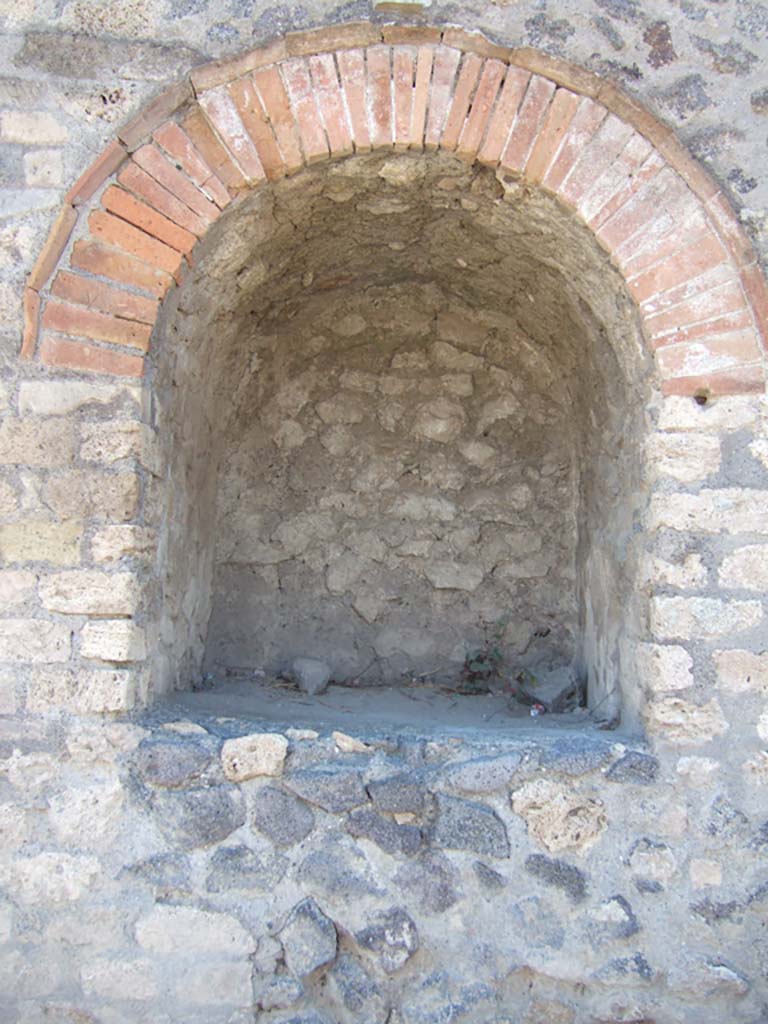
Pompeii II.4.7a. November 2024. Street shrine at east end of II.4. Photo courtesy of Annette Haug.

II.4.7a. Pompeii. October 2022. Street shrine at east end of II.4. Photo courtesy of Klaus Heese
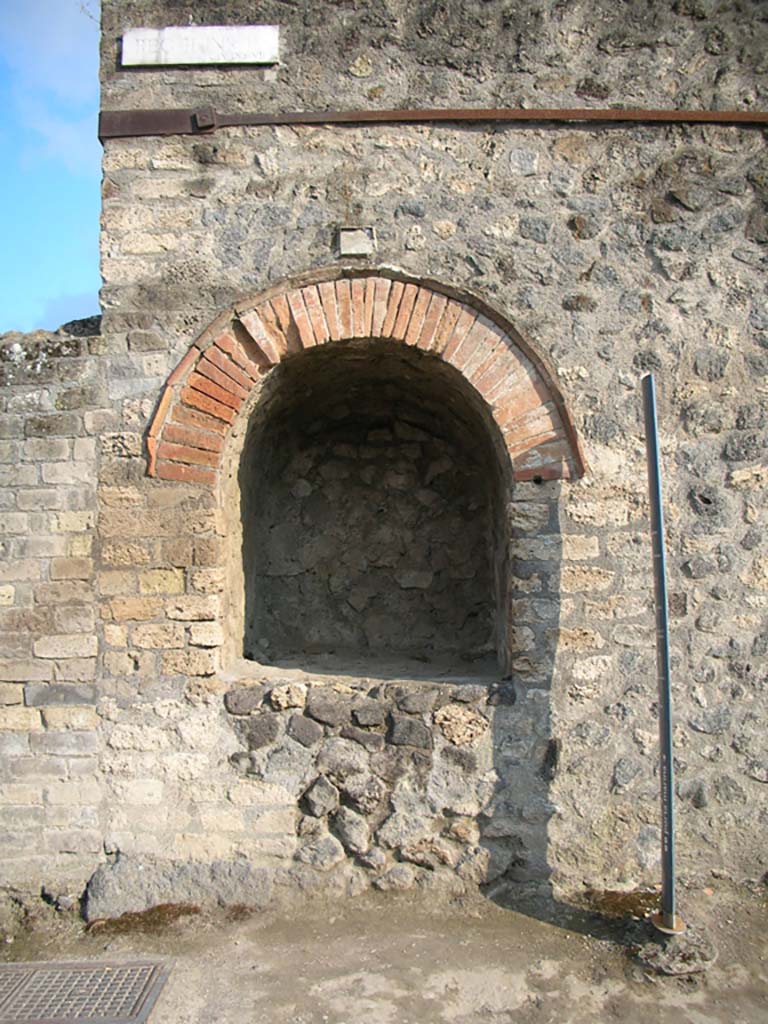
II.4.7a. Pompeii. May 2010. Street shrine at east end of II.4. Photo courtesy of Ivo van der Graaff.

Pompeii II.4.7a. September 2005. Street shrine at east end of II.4 on Via dell’Abbondanza.
According to Van der Poel, this great niche, which was used as a compitum, was discovered by Spinazzola in 1912.
See Van der Poel, H. B., 1986. Corpus Topographicum Pompeianum, Part IIIA. Austin: University of Texas. (p. 46).
According to Della Corte in NdS –
“Entirely excavated
was an important public shrine fronting the roadway, and resulting in a rounded
arched niche, 1.22m high; 1.06m wide; 1.08m deep, adorned above by a beautiful,
raised stucco cornice. The niche which opened onto the pavement at the height
of the breast of a man, was, as seems certain, a small temple in which the
Penates and the protecting Divinity of Pompeii were worshipped.”
See Notizie degli Scavi di Antichità, 1912, (p.68).
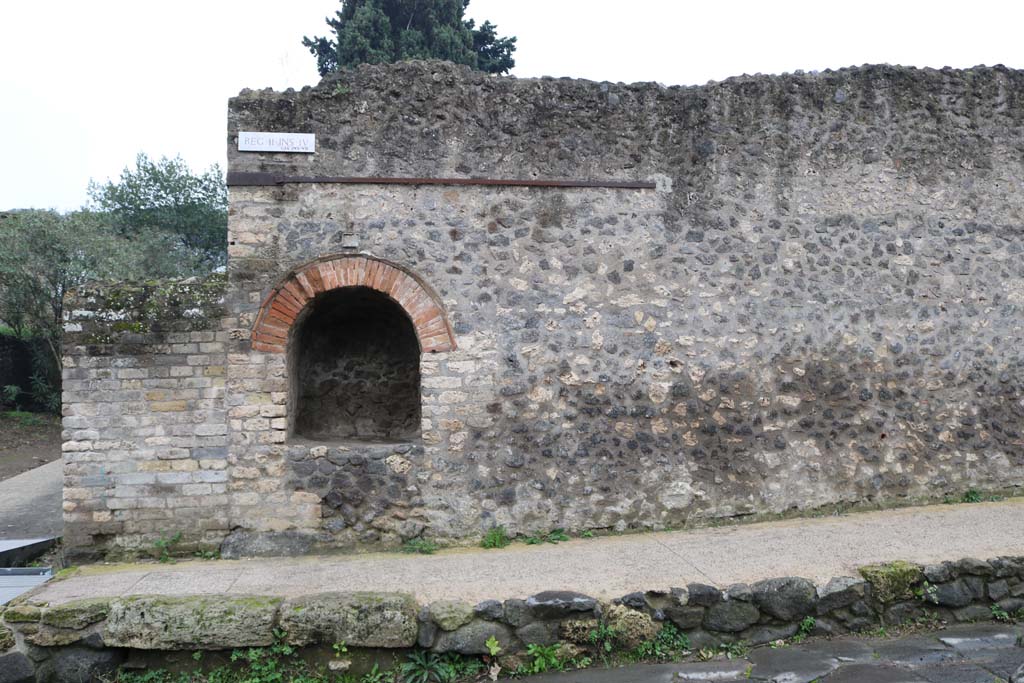
Pompeii II.4.7a. September 2005. Street shrine at east end of II.4 on Via dell’Abbondanza.
Compital aedicula shrine.
When excavated in 1912, the following description was given in the Notizie degli Scavi:
Opening on to the public street pavement was an important sacellum with an arched niche 1.22m tall, 1.06m wide and 1.08m deep.
It was ornamented above with a beautiful cornice in stucco plaster.
The niche was a small temple in which were venerated the Penates or the protecting divinities in Pompeii.
Two large holes with splinters of wood still attached were found in the floor of the shrine.
It was thought these were to anchor the figures of the Lares Compitales or were bases for them to stand on.
The statues had vanished, perhaps taken by ancient robbers who had cut a hole through the upper left corner of the shrine.
This damaged the decorative cornice and stucco relief on the façade.
A number of graffiti were found inside the niche and on the walls outside, scrawled in charcoal by passers-by.
These were CIL IV 8503-8516 and published by Della Corte.
See Rivista di Studi Pompeiani, Vol II, 1988: Parslow, C: Documents illustrating the excavations of the Praedia of Julia Felix (p.44).
See Notizie degli Scavi di Antichità, 1912,
p. 68.
According to Epigraphik-Datenbank Clauss/Slaby (See www.manfredclauss.de), these read –
Duobus
Fabis
fe[l(iciter)] [CIL IV 8503]
[Proc]ulus [CIL IV 8504]
Priscus caelator
Campano
gemmario
fel(iciter) [CIL IV 8505]
Procule
Postumi
va(le) [CIL IV 8506]
Lucciae
[ [CIL IV 8507]
Melisse va(le)
hac [CIL IV 8508]
"GR" (in greek) [CIL IV
8509]
Sabinus [CIL IV 8510]
Spes
a(ssibus) II [CIL IV 8511]
Ianuari
li(n)gis
[m]entula(m) [CIL IV 8512]
See Varone, A.,
2002. Erotica Pompeiana: Love
Inscriptions on the Walls of Pompeii, Rome: L’erma di Bretschneider. (p.139
for translation)
Con() [CIL IV 8513a]
Vesbin(us) Vesbinus [CIL IV 8513b]
Poppa(e)i cineri [CIL IV 8514]
Reus so(dalis) [CIL IV 8515]
Pompeianis
fel(iciter)
feliciter
Faustinum viginti
rogamus [CIL IV 8516]
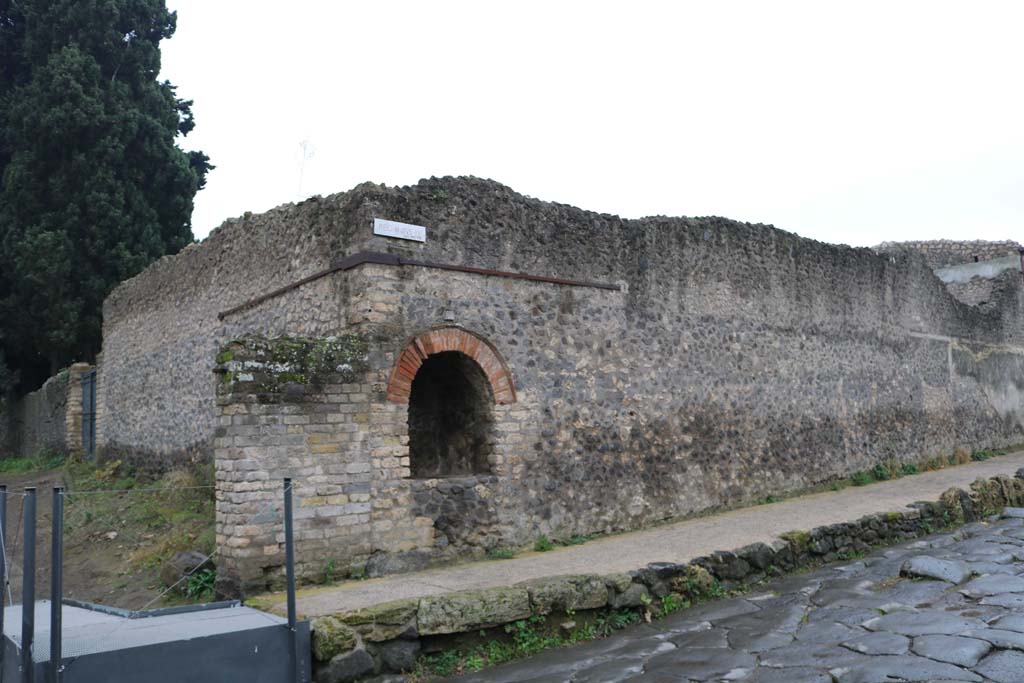
II.4.7a Pompeii. December 2004. Street shrine at east end of II.4 on Via dell’Abbondanza.
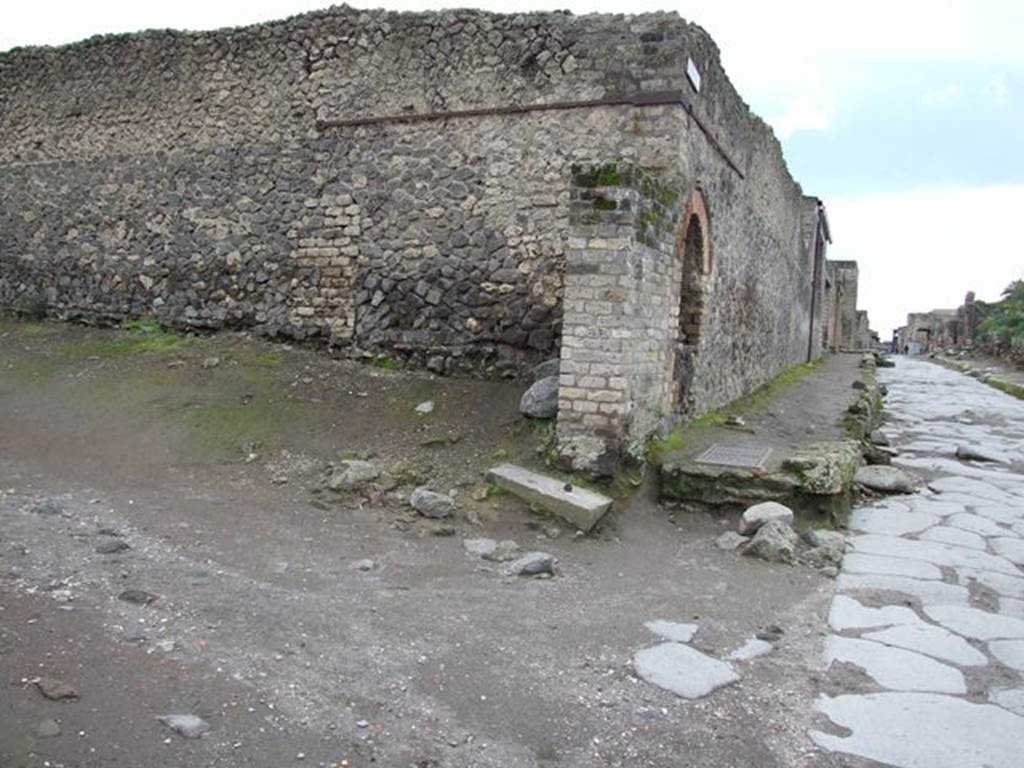
II.4.7a Pompeii, 1968. Arched street shrine at east end of II.4. Photo by Stanley A. Jashemski.
Source: The Wilhelmina and Stanley A. Jashemski archive in the University of Maryland Library, Special Collections (See collection page) and made available under the Creative Commons Attribution-Non Commercial License v.4. See Licence and use details.
J68f0652
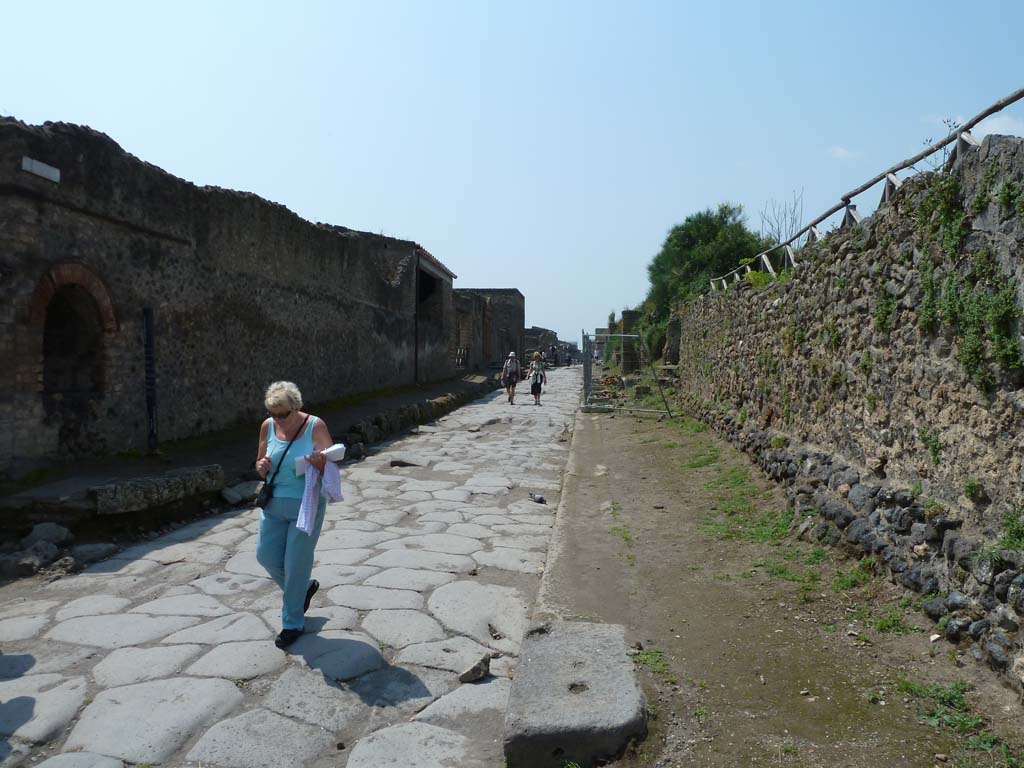
II.4.7a Pompeii. December 2018.
Exterior north-east corner of insula on south side of Via dell’Abbondanza, niche compitale. Photo courtesy of Aude Durand.
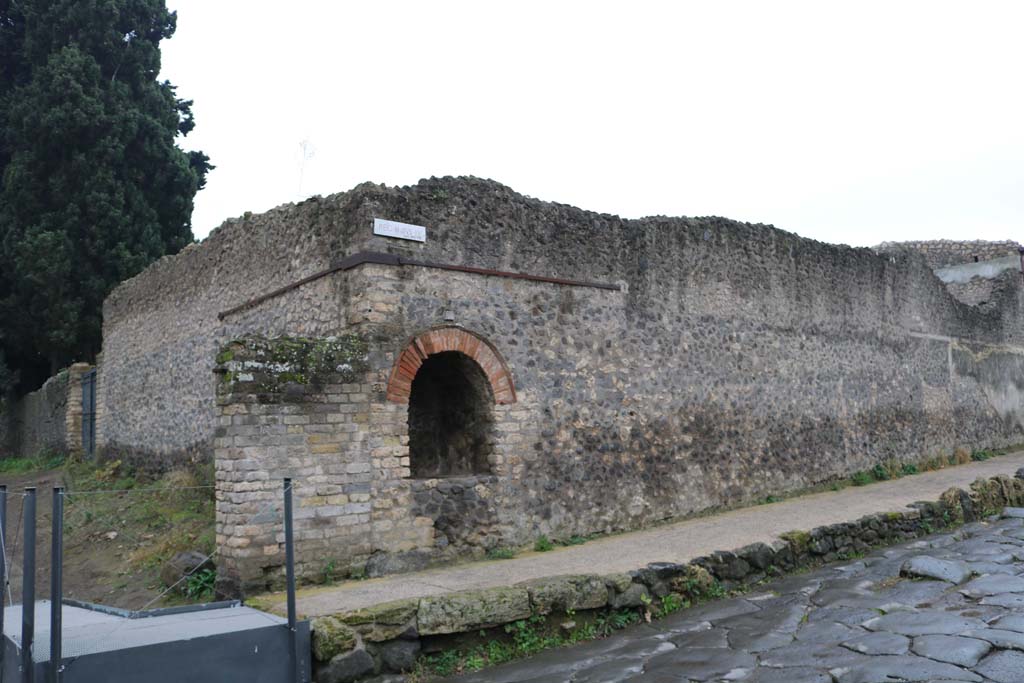
Pompeii II.4.7a. December 2018.
Street shrine on
north-east corner of II.4. Looking west along Via dell’Abbondanza from Vicolo
dell’ Anfiteatro. Photo
courtesy of Aude Durand.
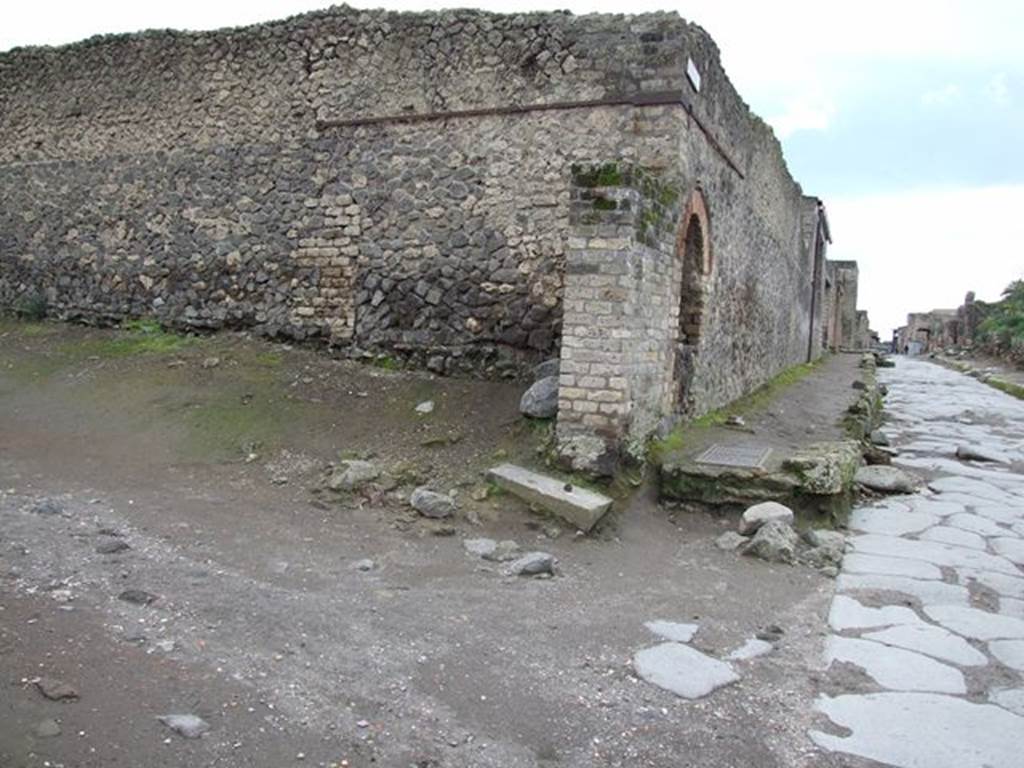
Pompeii II.4.7a. December 2005.
Street shrine on north-east corner of II.4. Looking west along Via dell’Abbondanza from Vicolo dell’ Anfiteatro.
According to Garcia y Garcia, the same two bombs that fell on 19th September 1943, also destroyed the remains of a roofed portal that could close Vicolo dell’ Anfiteatro at its north end.
This gateway would have closed the vicolo, which provided the only access by carts, wagons and chariots to the amphitheatre or Palaestra, as a form of traffic-control.
Only the pilaster, on the north-east side, which supported this street portal has been restored.
See Garcia y
Garcia, L., 2006. Danni di guerra a Pompei. Rome: L’Erma di Bretschneider. (p.46)
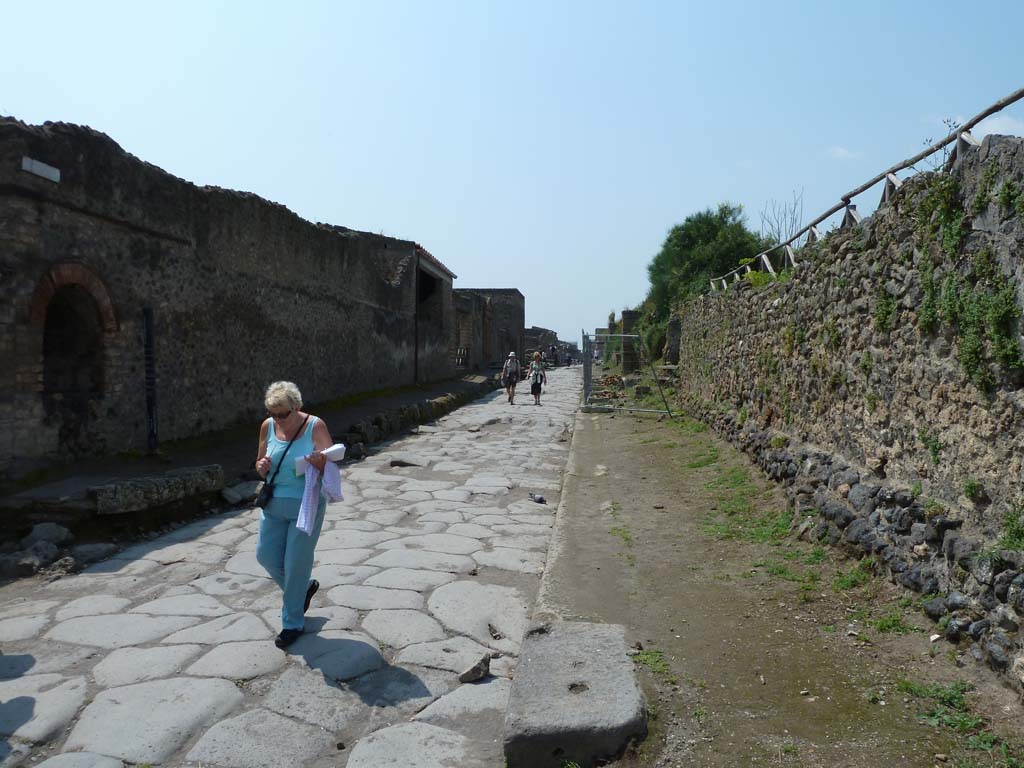
Pompeii II.4.7a. May 2010. Looking west past the street shrine along Via dell’Abbondanza.